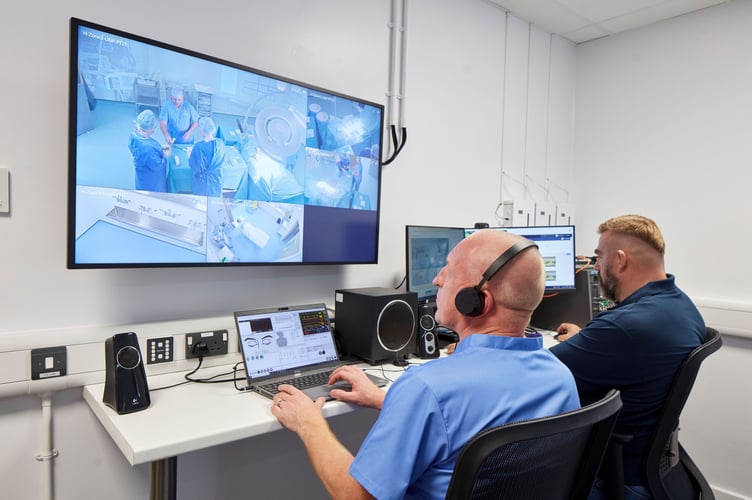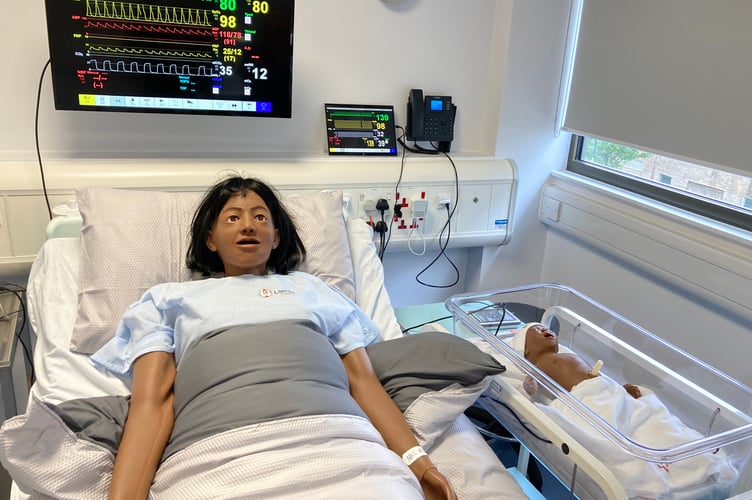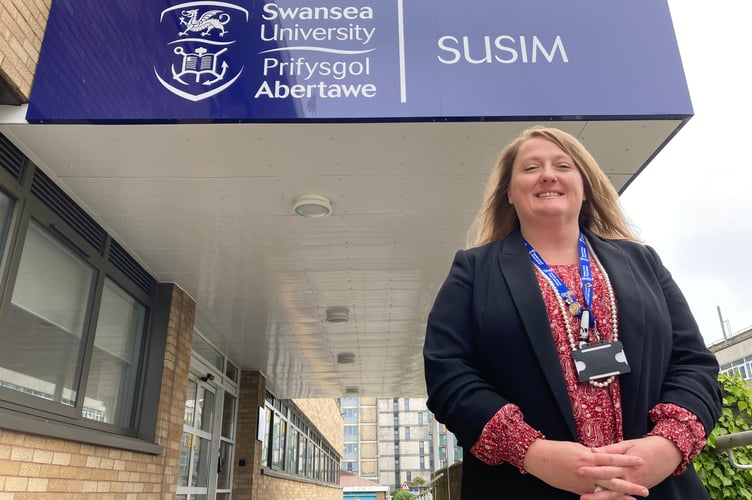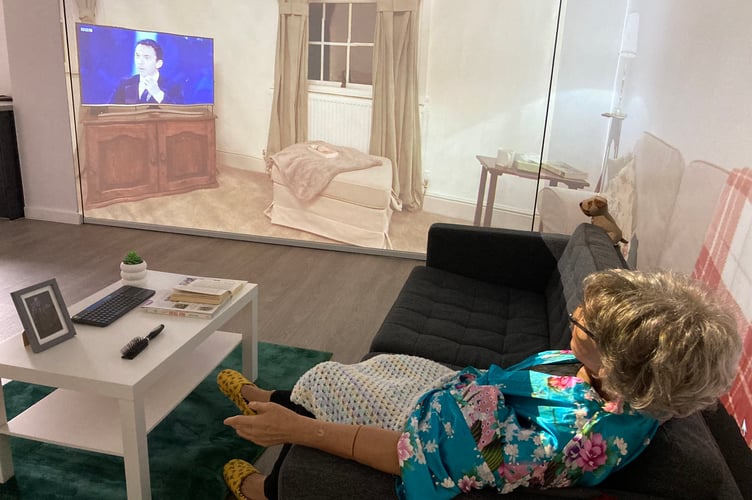In a former Welsh University teaching block dating from the 1990s - trainee doctors, nurses, midwives and paramedics step inside the future of learning at a £7m simulation centre helping to train tomorrow's healthcare workforce.
The Haldane Building at Singleton Campus at Swansea University opened its doors at the start of the 2023-24 academic year as the Simulation and Immersive Learning Centre (Susim) following a £7.2 million transformation.
It consists of eight simulation suites over two floors which recreate frontline healthcare settings like intensive care units, operating theatres, delivery units and cubicles. Projected onto the walls are real-life hospital interiors with staff moving around.
This, combined with the presence of medical equipment and mannequins which have a pulse, can breathe, blink, bleed and talk, plus different noises, smells and other distractions, enable trainees to apply their knowledge and learn from experience in an immersive environment.
One of the suites is a recreated home interior with a mannequin uncannily resembling an elderly woman on a sofa watching television.
It can be rearranged to replicate, for example, a home lived in by a hoarder and it’s used by trainee doctors, community nurses, midwives and occupational therapists among others. There are also three simulation suites at the university’s campus at St David’s Park, Carmarthen.
The simulated intensive care unit at Singleton Campus has a glass wall on one side, behind which sit trainers and tech staff in a control room who assess students do things like insert cannulas and take blood.

Head of simulation at Susim, Associate Professor Joanne Davies, said medical students still spent up to half their course on placements as well as attending lectures and completing online modules: ”They get to practise here first. We’d rather they make mistakes here than with patients.”
When Assoc Prof Davies was training to be a midwife in the mid-1990s virtual reality and touch-screen technology was the realm of fiction. She recalled practising on a recreated pelvis and a doll and poring through a lot of textbooks before getting invaluable hands-on experience in real-world settings.
“There was nothing like this,” she said, referring to Susim. “I feel the new generation of learners want to train differently. They are being brought up in a different age of technology. We see the reaction of students – it’s highly positive.”
Asked whether simulated learning would have benefited her when she was studying midwifery, Assoc Prof Davies said: “Yes, incredibly. It’s just a different world.”
She said her hands-on training on the job was excellent but could be overwhelming for some learners and that drop-rates were quite high.
The simulation centre is also being used by health boards to develop and train their workforces. It’s so adaptable that, for example, a university security training event took place there in which scenarios such as a rowdy student house party were recreated. The interior of a law court has also been filmed.
The hope is that emergency blue-light services and sectors ranging from aviation, television production and sports bodies will experience what it has to offer, and with that in mind a Susim business arm has been created.

Assoc Prof Davies spent many years working as a midwife, often in hospitals with affiliated universities.
She combined clinical work with education and had designed simulation centres before taking up her current post at Swansea University four years ago.
She said the timing worked out well as the university had been asked by Health Education and Improvement Wales – the country’s strategic workforce body for NHS Wales – to expand simulation-based learning and shared learning among professions.
Before the centre opened Assoc Prof Davies said the university operated some simulation-based learning but that it was more dispersed and classroom-based.
Students and postgraduates using the suites at the Haldane Building have a pre-brief before their task and then a debrief afterwards. Assoc Prof Davies said it developed their communication skills: “I think the biggest thing is that simulation has a direct impact on team performance and increasing patient safety.”
She said it was also particularly useful for the recreation of “high-risk, low-volume” scenarios, such as post-partum haemorrhages, which medics may not see that regularly but which came with potentially severe consequences: “If you don’t get that exposure you can become cognitively overloaded in the moment.”

Recruiting and retaining the likes of GPs and nurses isn’t easy, and the simulation centre opens its doors to young people who might be thinking about a career in the sector. Open days are also held there. Assoc Prof Davies said she felt the positive aspects about working in healthcare needed accentuating.
“Yes, it is absolutely challenging but there’s a flip side – you have fantastic careers and give a lot back to the patients and families you care for,” she said.
Healthcare staff, she added, loved what they did and were dedicated. “We need to instil that in the next generation.”
The simulation centre has a virtual reality room, thanks to a £900,000 grant from the Higher Education Funding Council for Wales, in which students wear headsets and operate hand controls and deal with scenarios such as a blood transfusion or a child experiencing a diabetic emergency.
What they do with their wearable tech is projected onto a screen. One training session enabled students to feel what it was like from the perspective of a deaf patient with no-one to translate sign language. “The first time I did it, it made my cry,” said Assoc Prof Davies.
The centre employs five tech staff known as technologists, with a sixth at the smaller St David’s Park site in Carmarthenshire.
Assoc Prof Davies said Susim was the largest installation of immersive wall technology of its kind globally.
Children’s nursing student Rosie Read said the centre had been massively beneficial to her training: “It allows you to immerse yourself in a realistic environment while still being in a safe space to learn,” she said.
“Also, we can develop new skills and interact with members from other disciplines which is great preparation for placement and qualified practice.”
Fellow nursing student Cerys Evans said: “Running through different scenarios, such as responding to an anaphylaxis episode and a resuscitation, gives students more of an idea of what is expected of them in practice and takes away some of the anxiety and fear around dealing with these situations.”

Dr David Lee, simulation lead at Swansea University, said the centre had invigorated the clinical skills training at the heart of the graduate entry medical programme: “From first years to final years, students have had the chance to immerse themselves in realistic clinical situations that prepare them for life as a newly-qualified doctor.”
“Besides the accurate portrayal of wards, theatres and primary care environments, the immersive environment also allows data interpretation and clinical problem-solving to be performed together.”
During the tour Assoc Prof Davies programmes a mannequin baby to cry out and gesticulate with its arm, accompanied by a bleeping sound from a medical device. It really brings home the skill and professionalism that a midwife or other clinician would need to handle the situation.
Walking past a recreated hospital cubicle a short while later a bed-bound adult mannequin blinks as I pass. It all feels as real-life as it could possibly be.




